Comprehensive Report on Hazardous Waste Management in Northern India
VerifiedAdded on 2020/03/02
|10
|2508
|151
Report
AI Summary
This report provides an in-depth analysis of hazardous waste management in Northern India, focusing on the challenges faced due to rapid urbanization and industrial growth. It explores the generation and physical characteristics of hazardous waste, identifying the major sources and types, including solid, liquid, gaseous, and sludge waste. The report examines the existing waste management systems, including institutional and financial aspects, and highlights the key problems and challenges, such as the lack of proper segregation and categorization of waste. It also delves into the prediction of future waste quantities based on population growth and discusses the impact of waste on the environment and public health. The study concludes with recommendations for strengthening waste management practices through effective policies, technological advancements, and public awareness, emphasizing the shared responsibility of citizens and the government in waste disposal and environmental protection. This assignment is contributed by a student and available on Desklib.
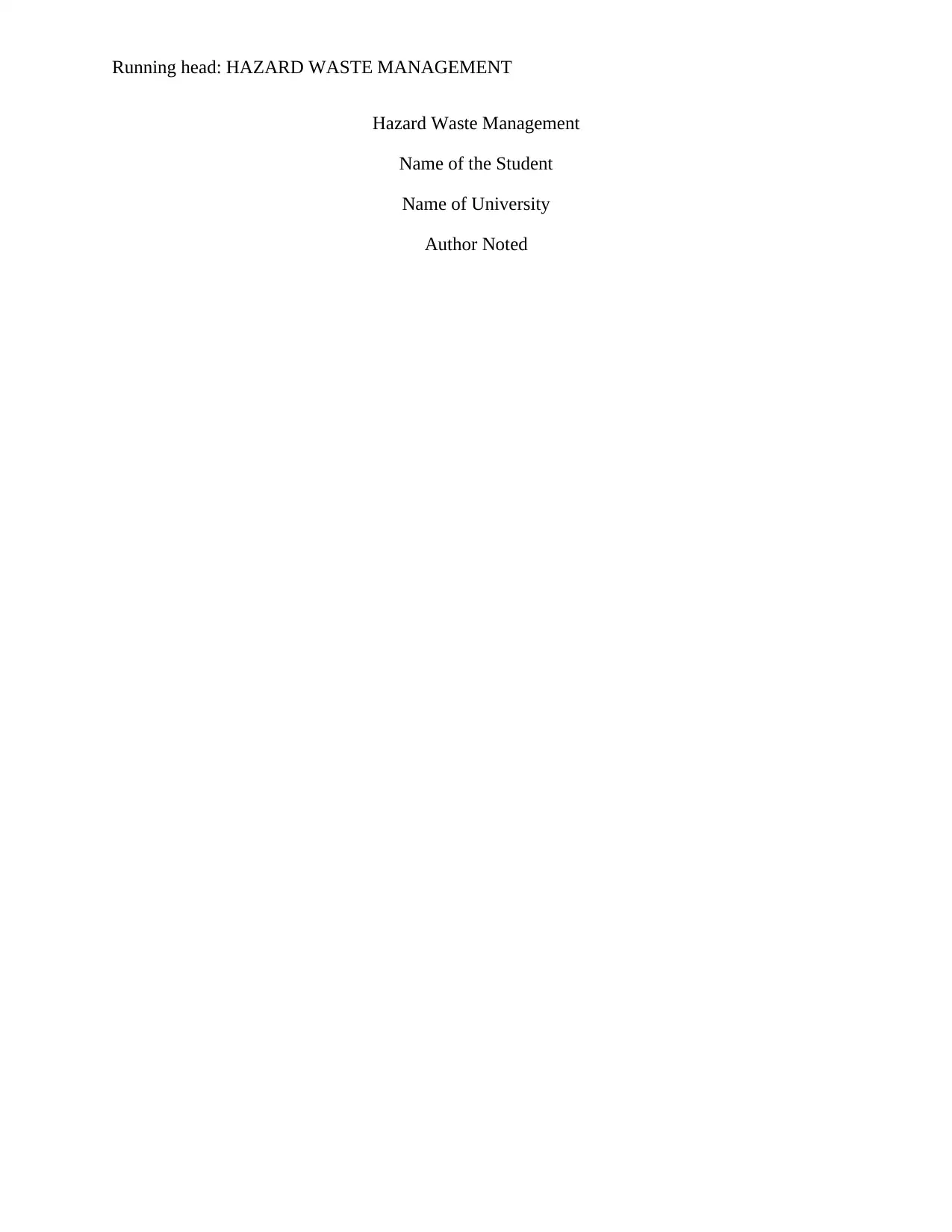
Running head: HAZARD WASTE MANAGEMENT
Hazard Waste Management
Name of the Student
Name of University
Author Noted
Hazard Waste Management
Name of the Student
Name of University
Author Noted
Paraphrase This Document
Need a fresh take? Get an instant paraphrase of this document with our AI Paraphraser
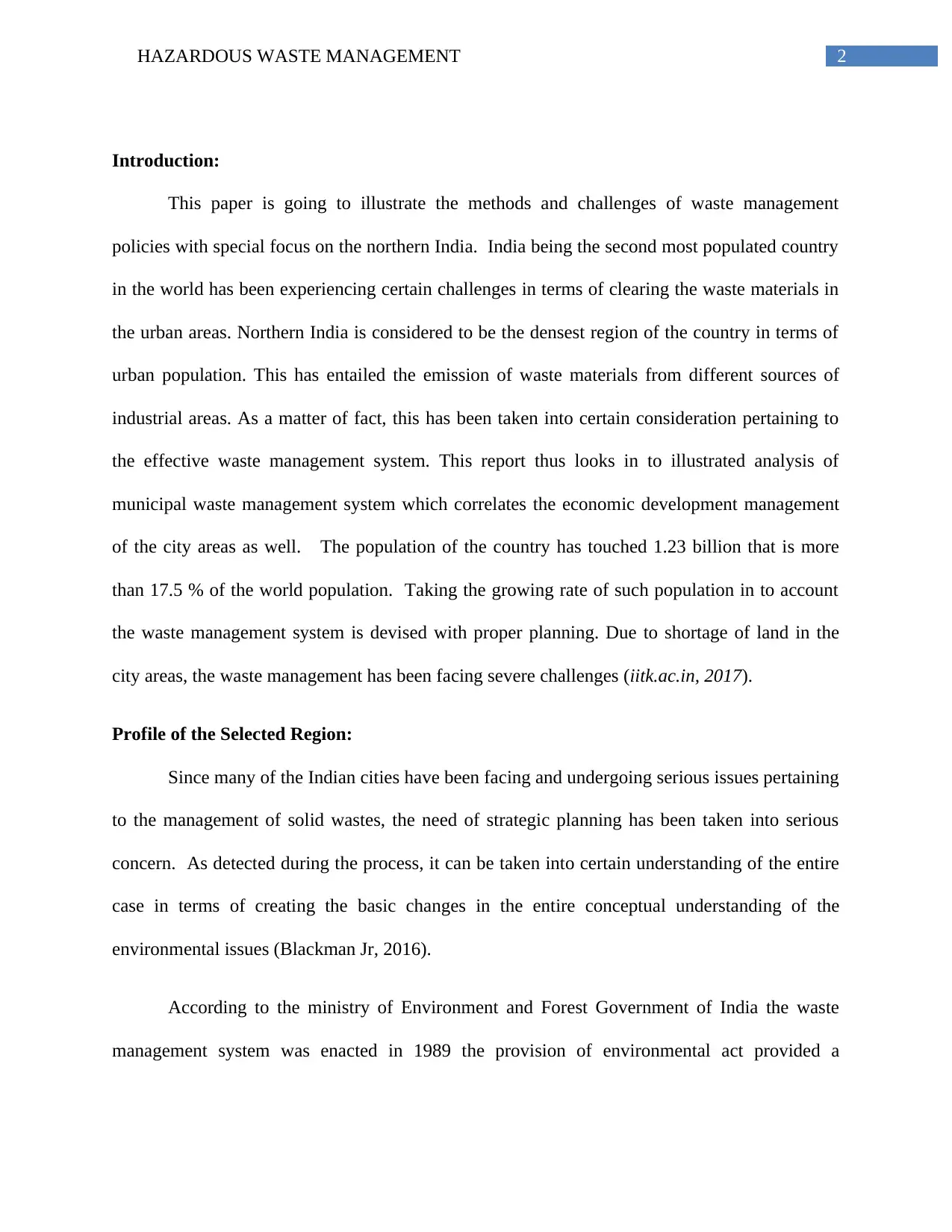
2HAZARDOUS WASTE MANAGEMENT
Introduction:
This paper is going to illustrate the methods and challenges of waste management
policies with special focus on the northern India. India being the second most populated country
in the world has been experiencing certain challenges in terms of clearing the waste materials in
the urban areas. Northern India is considered to be the densest region of the country in terms of
urban population. This has entailed the emission of waste materials from different sources of
industrial areas. As a matter of fact, this has been taken into certain consideration pertaining to
the effective waste management system. This report thus looks in to illustrated analysis of
municipal waste management system which correlates the economic development management
of the city areas as well. The population of the country has touched 1.23 billion that is more
than 17.5 % of the world population. Taking the growing rate of such population in to account
the waste management system is devised with proper planning. Due to shortage of land in the
city areas, the waste management has been facing severe challenges (iitk.ac.in, 2017).
Profile of the Selected Region:
Since many of the Indian cities have been facing and undergoing serious issues pertaining
to the management of solid wastes, the need of strategic planning has been taken into serious
concern. As detected during the process, it can be taken into certain understanding of the entire
case in terms of creating the basic changes in the entire conceptual understanding of the
environmental issues (Blackman Jr, 2016).
According to the ministry of Environment and Forest Government of India the waste
management system was enacted in 1989 the provision of environmental act provided a
Introduction:
This paper is going to illustrate the methods and challenges of waste management
policies with special focus on the northern India. India being the second most populated country
in the world has been experiencing certain challenges in terms of clearing the waste materials in
the urban areas. Northern India is considered to be the densest region of the country in terms of
urban population. This has entailed the emission of waste materials from different sources of
industrial areas. As a matter of fact, this has been taken into certain consideration pertaining to
the effective waste management system. This report thus looks in to illustrated analysis of
municipal waste management system which correlates the economic development management
of the city areas as well. The population of the country has touched 1.23 billion that is more
than 17.5 % of the world population. Taking the growing rate of such population in to account
the waste management system is devised with proper planning. Due to shortage of land in the
city areas, the waste management has been facing severe challenges (iitk.ac.in, 2017).
Profile of the Selected Region:
Since many of the Indian cities have been facing and undergoing serious issues pertaining
to the management of solid wastes, the need of strategic planning has been taken into serious
concern. As detected during the process, it can be taken into certain understanding of the entire
case in terms of creating the basic changes in the entire conceptual understanding of the
environmental issues (Blackman Jr, 2016).
According to the ministry of Environment and Forest Government of India the waste
management system was enacted in 1989 the provision of environmental act provided a
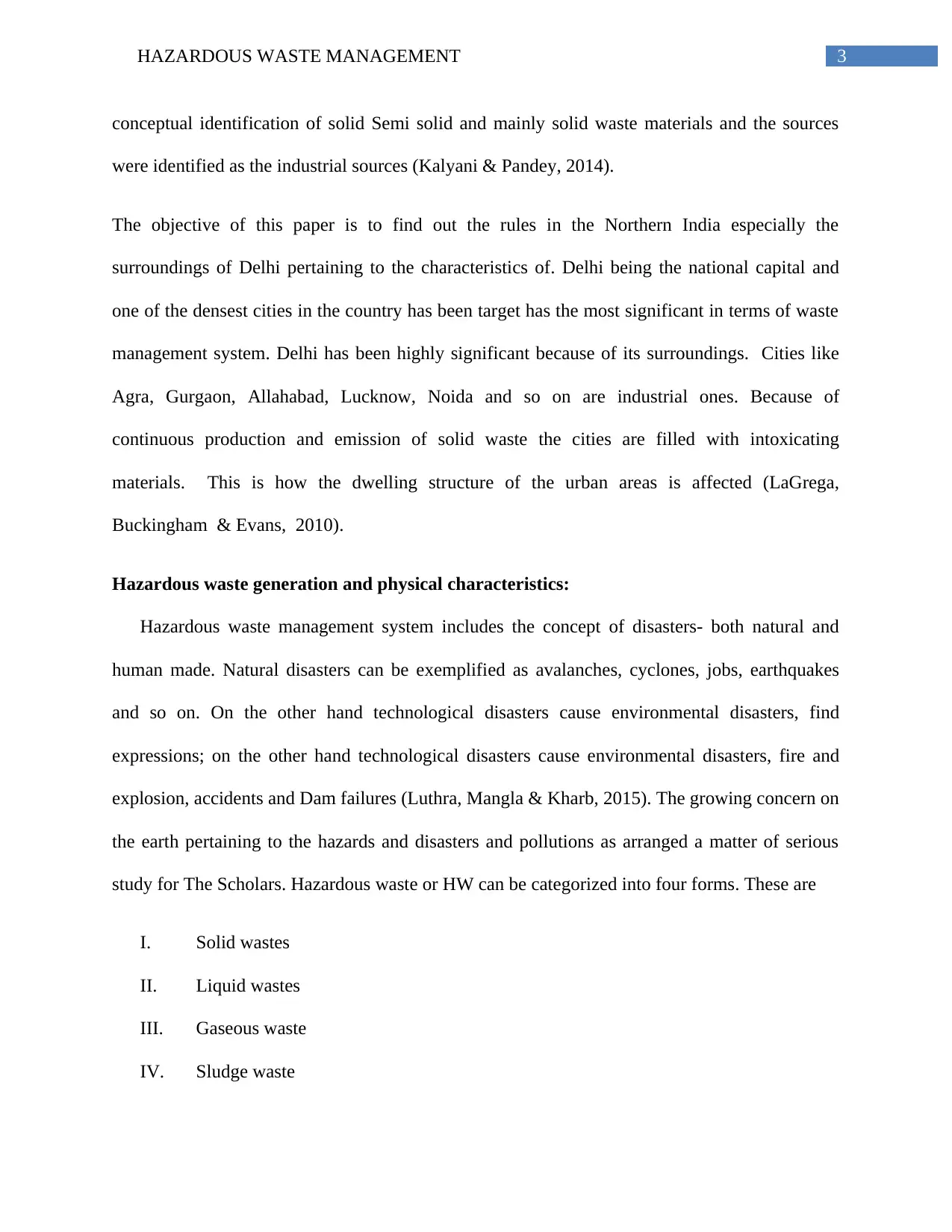
3HAZARDOUS WASTE MANAGEMENT
conceptual identification of solid Semi solid and mainly solid waste materials and the sources
were identified as the industrial sources (Kalyani & Pandey, 2014).
The objective of this paper is to find out the rules in the Northern India especially the
surroundings of Delhi pertaining to the characteristics of. Delhi being the national capital and
one of the densest cities in the country has been target has the most significant in terms of waste
management system. Delhi has been highly significant because of its surroundings. Cities like
Agra, Gurgaon, Allahabad, Lucknow, Noida and so on are industrial ones. Because of
continuous production and emission of solid waste the cities are filled with intoxicating
materials. This is how the dwelling structure of the urban areas is affected (LaGrega,
Buckingham & Evans, 2010).
Hazardous waste generation and physical characteristics:
Hazardous waste management system includes the concept of disasters- both natural and
human made. Natural disasters can be exemplified as avalanches, cyclones, jobs, earthquakes
and so on. On the other hand technological disasters cause environmental disasters, find
expressions; on the other hand technological disasters cause environmental disasters, fire and
explosion, accidents and Dam failures (Luthra, Mangla & Kharb, 2015). The growing concern on
the earth pertaining to the hazards and disasters and pollutions as arranged a matter of serious
study for The Scholars. Hazardous waste or HW can be categorized into four forms. These are
I. Solid wastes
II. Liquid wastes
III. Gaseous waste
IV. Sludge waste
conceptual identification of solid Semi solid and mainly solid waste materials and the sources
were identified as the industrial sources (Kalyani & Pandey, 2014).
The objective of this paper is to find out the rules in the Northern India especially the
surroundings of Delhi pertaining to the characteristics of. Delhi being the national capital and
one of the densest cities in the country has been target has the most significant in terms of waste
management system. Delhi has been highly significant because of its surroundings. Cities like
Agra, Gurgaon, Allahabad, Lucknow, Noida and so on are industrial ones. Because of
continuous production and emission of solid waste the cities are filled with intoxicating
materials. This is how the dwelling structure of the urban areas is affected (LaGrega,
Buckingham & Evans, 2010).
Hazardous waste generation and physical characteristics:
Hazardous waste management system includes the concept of disasters- both natural and
human made. Natural disasters can be exemplified as avalanches, cyclones, jobs, earthquakes
and so on. On the other hand technological disasters cause environmental disasters, find
expressions; on the other hand technological disasters cause environmental disasters, fire and
explosion, accidents and Dam failures (Luthra, Mangla & Kharb, 2015). The growing concern on
the earth pertaining to the hazards and disasters and pollutions as arranged a matter of serious
study for The Scholars. Hazardous waste or HW can be categorized into four forms. These are
I. Solid wastes
II. Liquid wastes
III. Gaseous waste
IV. Sludge waste
⊘ This is a preview!⊘
Do you want full access?
Subscribe today to unlock all pages.

Trusted by 1+ million students worldwide
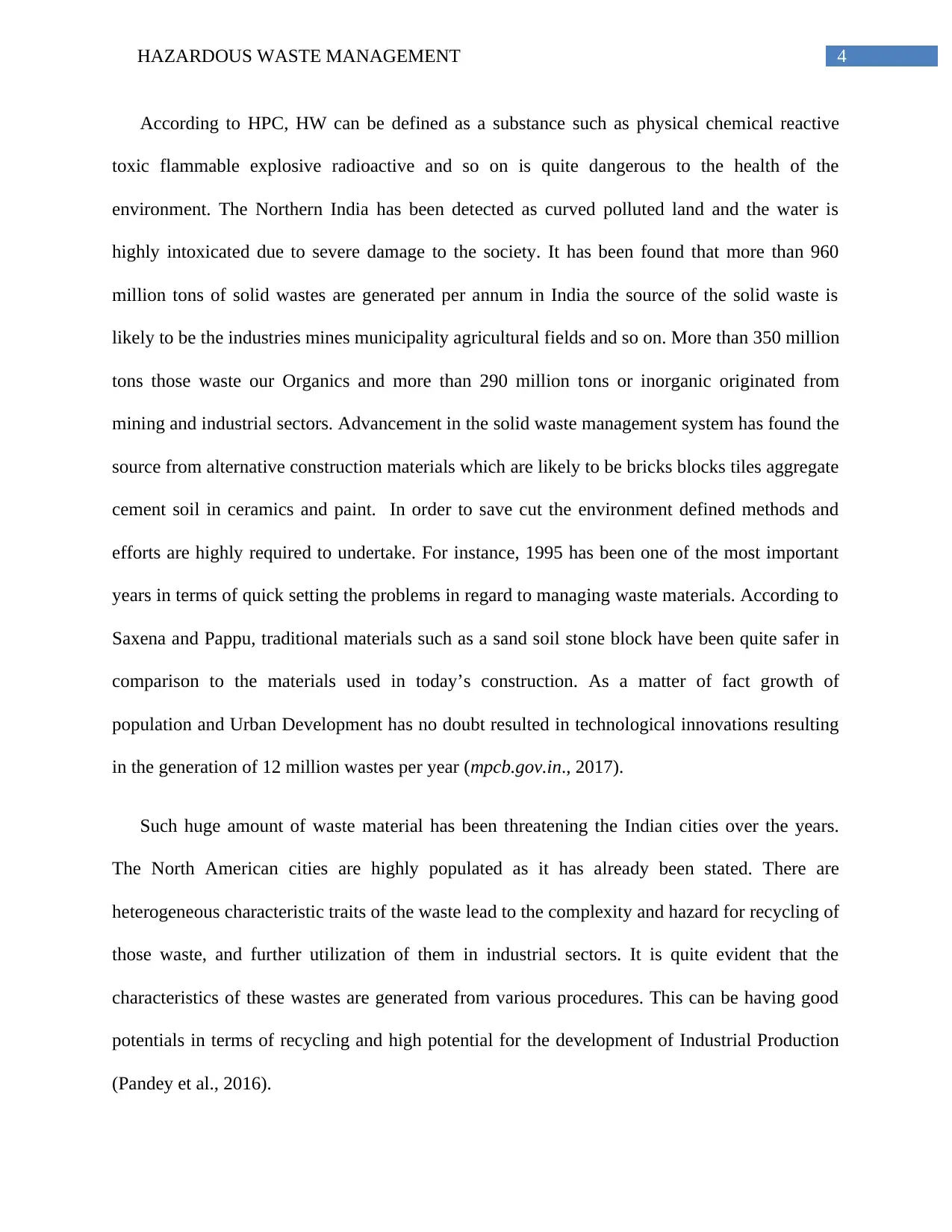
4HAZARDOUS WASTE MANAGEMENT
According to HPC, HW can be defined as a substance such as physical chemical reactive
toxic flammable explosive radioactive and so on is quite dangerous to the health of the
environment. The Northern India has been detected as curved polluted land and the water is
highly intoxicated due to severe damage to the society. It has been found that more than 960
million tons of solid wastes are generated per annum in India the source of the solid waste is
likely to be the industries mines municipality agricultural fields and so on. More than 350 million
tons those waste our Organics and more than 290 million tons or inorganic originated from
mining and industrial sectors. Advancement in the solid waste management system has found the
source from alternative construction materials which are likely to be bricks blocks tiles aggregate
cement soil in ceramics and paint. In order to save cut the environment defined methods and
efforts are highly required to undertake. For instance, 1995 has been one of the most important
years in terms of quick setting the problems in regard to managing waste materials. According to
Saxena and Pappu, traditional materials such as a sand soil stone block have been quite safer in
comparison to the materials used in today’s construction. As a matter of fact growth of
population and Urban Development has no doubt resulted in technological innovations resulting
in the generation of 12 million wastes per year (mpcb.gov.in., 2017).
Such huge amount of waste material has been threatening the Indian cities over the years.
The North American cities are highly populated as it has already been stated. There are
heterogeneous characteristic traits of the waste lead to the complexity and hazard for recycling of
those waste, and further utilization of them in industrial sectors. It is quite evident that the
characteristics of these wastes are generated from various procedures. This can be having good
potentials in terms of recycling and high potential for the development of Industrial Production
(Pandey et al., 2016).
According to HPC, HW can be defined as a substance such as physical chemical reactive
toxic flammable explosive radioactive and so on is quite dangerous to the health of the
environment. The Northern India has been detected as curved polluted land and the water is
highly intoxicated due to severe damage to the society. It has been found that more than 960
million tons of solid wastes are generated per annum in India the source of the solid waste is
likely to be the industries mines municipality agricultural fields and so on. More than 350 million
tons those waste our Organics and more than 290 million tons or inorganic originated from
mining and industrial sectors. Advancement in the solid waste management system has found the
source from alternative construction materials which are likely to be bricks blocks tiles aggregate
cement soil in ceramics and paint. In order to save cut the environment defined methods and
efforts are highly required to undertake. For instance, 1995 has been one of the most important
years in terms of quick setting the problems in regard to managing waste materials. According to
Saxena and Pappu, traditional materials such as a sand soil stone block have been quite safer in
comparison to the materials used in today’s construction. As a matter of fact growth of
population and Urban Development has no doubt resulted in technological innovations resulting
in the generation of 12 million wastes per year (mpcb.gov.in., 2017).
Such huge amount of waste material has been threatening the Indian cities over the years.
The North American cities are highly populated as it has already been stated. There are
heterogeneous characteristic traits of the waste lead to the complexity and hazard for recycling of
those waste, and further utilization of them in industrial sectors. It is quite evident that the
characteristics of these wastes are generated from various procedures. This can be having good
potentials in terms of recycling and high potential for the development of Industrial Production
(Pandey et al., 2016).
Paraphrase This Document
Need a fresh take? Get an instant paraphrase of this document with our AI Paraphraser
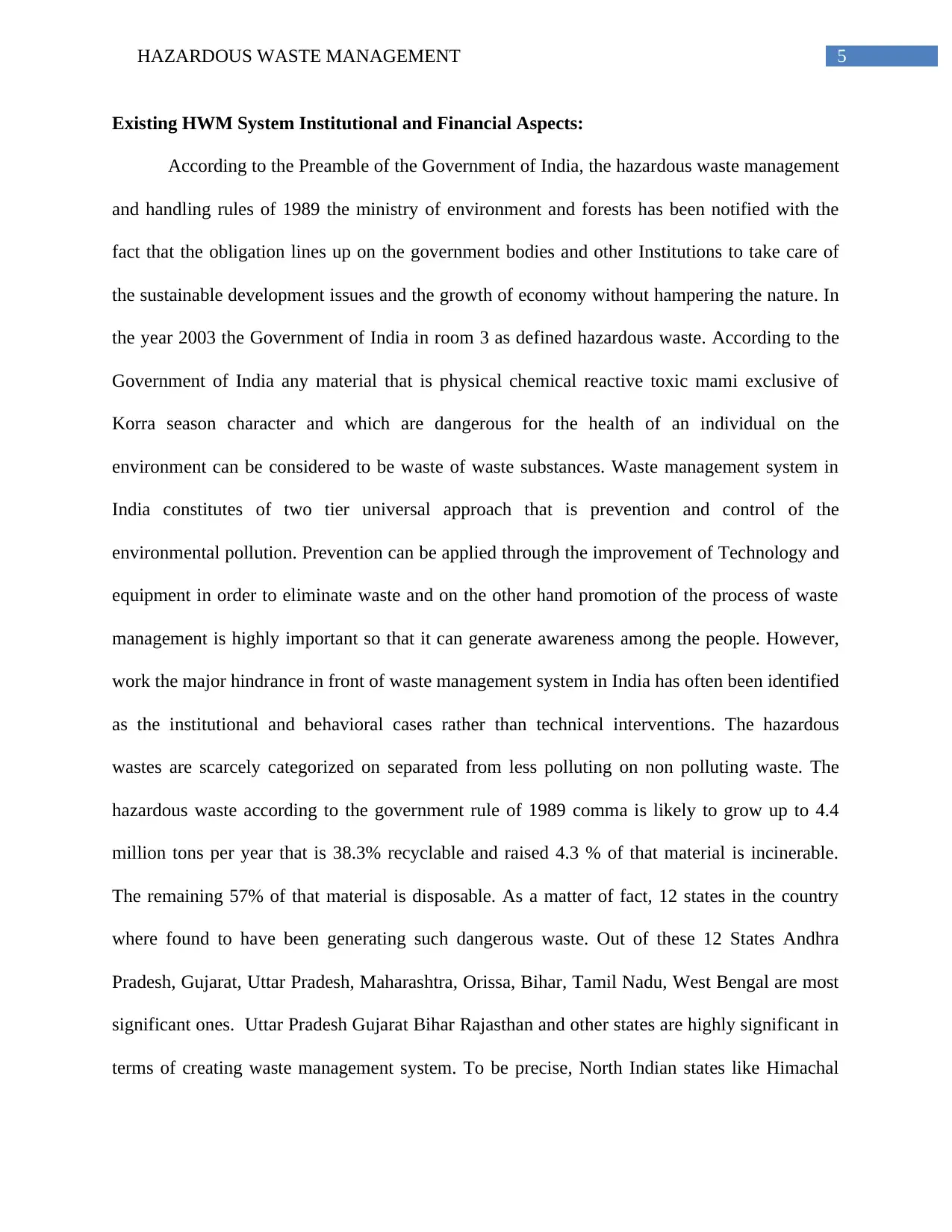
5HAZARDOUS WASTE MANAGEMENT
Existing HWM System Institutional and Financial Aspects:
According to the Preamble of the Government of India, the hazardous waste management
and handling rules of 1989 the ministry of environment and forests has been notified with the
fact that the obligation lines up on the government bodies and other Institutions to take care of
the sustainable development issues and the growth of economy without hampering the nature. In
the year 2003 the Government of India in room 3 as defined hazardous waste. According to the
Government of India any material that is physical chemical reactive toxic mami exclusive of
Korra season character and which are dangerous for the health of an individual on the
environment can be considered to be waste of waste substances. Waste management system in
India constitutes of two tier universal approach that is prevention and control of the
environmental pollution. Prevention can be applied through the improvement of Technology and
equipment in order to eliminate waste and on the other hand promotion of the process of waste
management is highly important so that it can generate awareness among the people. However,
work the major hindrance in front of waste management system in India has often been identified
as the institutional and behavioral cases rather than technical interventions. The hazardous
wastes are scarcely categorized on separated from less polluting on non polluting waste. The
hazardous waste according to the government rule of 1989 comma is likely to grow up to 4.4
million tons per year that is 38.3% recyclable and raised 4.3 % of that material is incinerable.
The remaining 57% of that material is disposable. As a matter of fact, 12 states in the country
where found to have been generating such dangerous waste. Out of these 12 States Andhra
Pradesh, Gujarat, Uttar Pradesh, Maharashtra, Orissa, Bihar, Tamil Nadu, West Bengal are most
significant ones. Uttar Pradesh Gujarat Bihar Rajasthan and other states are highly significant in
terms of creating waste management system. To be precise, North Indian states like Himachal
Existing HWM System Institutional and Financial Aspects:
According to the Preamble of the Government of India, the hazardous waste management
and handling rules of 1989 the ministry of environment and forests has been notified with the
fact that the obligation lines up on the government bodies and other Institutions to take care of
the sustainable development issues and the growth of economy without hampering the nature. In
the year 2003 the Government of India in room 3 as defined hazardous waste. According to the
Government of India any material that is physical chemical reactive toxic mami exclusive of
Korra season character and which are dangerous for the health of an individual on the
environment can be considered to be waste of waste substances. Waste management system in
India constitutes of two tier universal approach that is prevention and control of the
environmental pollution. Prevention can be applied through the improvement of Technology and
equipment in order to eliminate waste and on the other hand promotion of the process of waste
management is highly important so that it can generate awareness among the people. However,
work the major hindrance in front of waste management system in India has often been identified
as the institutional and behavioral cases rather than technical interventions. The hazardous
wastes are scarcely categorized on separated from less polluting on non polluting waste. The
hazardous waste according to the government rule of 1989 comma is likely to grow up to 4.4
million tons per year that is 38.3% recyclable and raised 4.3 % of that material is incinerable.
The remaining 57% of that material is disposable. As a matter of fact, 12 states in the country
where found to have been generating such dangerous waste. Out of these 12 States Andhra
Pradesh, Gujarat, Uttar Pradesh, Maharashtra, Orissa, Bihar, Tamil Nadu, West Bengal are most
significant ones. Uttar Pradesh Gujarat Bihar Rajasthan and other states are highly significant in
terms of creating waste management system. To be precise, North Indian states like Himachal
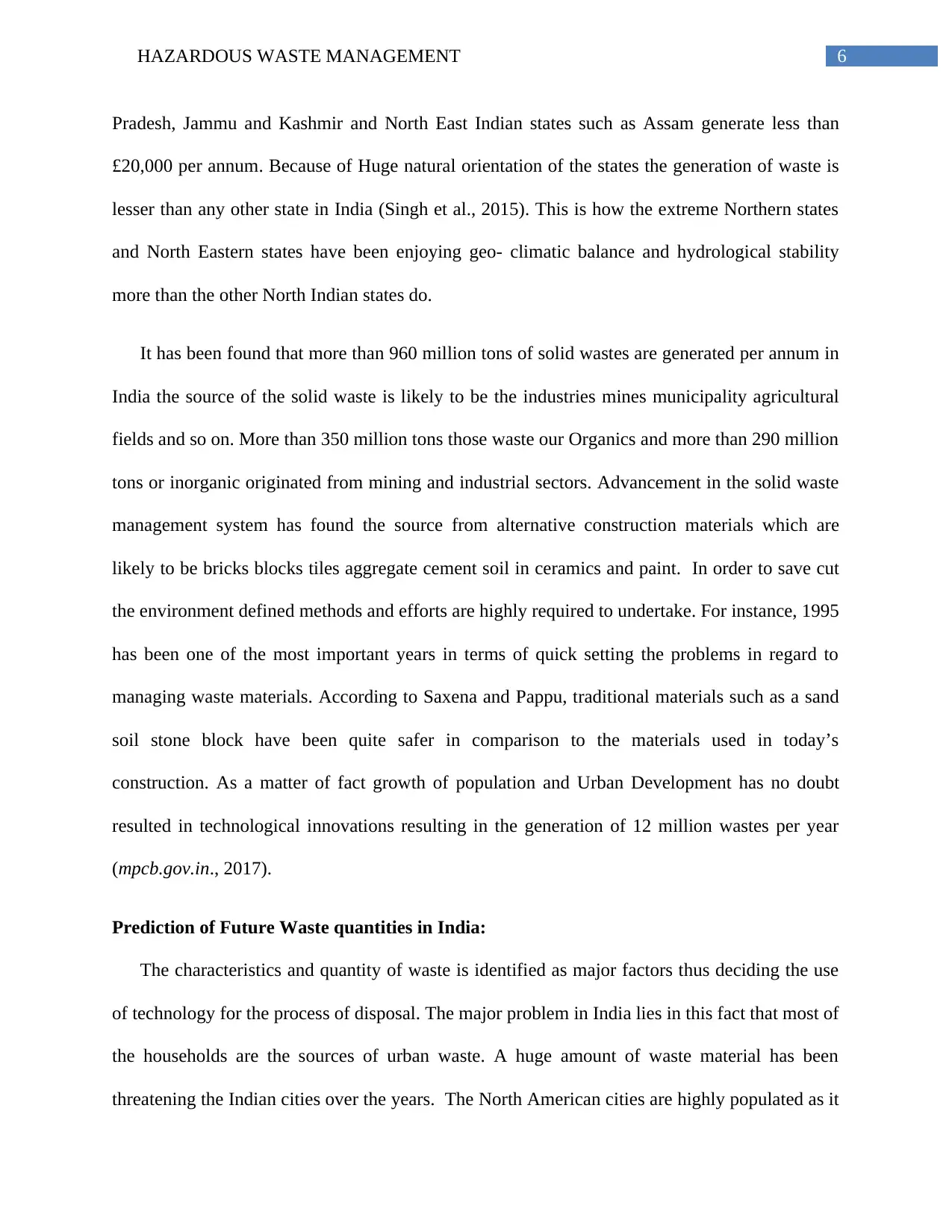
6HAZARDOUS WASTE MANAGEMENT
Pradesh, Jammu and Kashmir and North East Indian states such as Assam generate less than
£20,000 per annum. Because of Huge natural orientation of the states the generation of waste is
lesser than any other state in India (Singh et al., 2015). This is how the extreme Northern states
and North Eastern states have been enjoying geo- climatic balance and hydrological stability
more than the other North Indian states do.
It has been found that more than 960 million tons of solid wastes are generated per annum in
India the source of the solid waste is likely to be the industries mines municipality agricultural
fields and so on. More than 350 million tons those waste our Organics and more than 290 million
tons or inorganic originated from mining and industrial sectors. Advancement in the solid waste
management system has found the source from alternative construction materials which are
likely to be bricks blocks tiles aggregate cement soil in ceramics and paint. In order to save cut
the environment defined methods and efforts are highly required to undertake. For instance, 1995
has been one of the most important years in terms of quick setting the problems in regard to
managing waste materials. According to Saxena and Pappu, traditional materials such as a sand
soil stone block have been quite safer in comparison to the materials used in today’s
construction. As a matter of fact growth of population and Urban Development has no doubt
resulted in technological innovations resulting in the generation of 12 million wastes per year
(mpcb.gov.in., 2017).
Prediction of Future Waste quantities in India:
The characteristics and quantity of waste is identified as major factors thus deciding the use
of technology for the process of disposal. The major problem in India lies in this fact that most of
the households are the sources of urban waste. A huge amount of waste material has been
threatening the Indian cities over the years. The North American cities are highly populated as it
Pradesh, Jammu and Kashmir and North East Indian states such as Assam generate less than
£20,000 per annum. Because of Huge natural orientation of the states the generation of waste is
lesser than any other state in India (Singh et al., 2015). This is how the extreme Northern states
and North Eastern states have been enjoying geo- climatic balance and hydrological stability
more than the other North Indian states do.
It has been found that more than 960 million tons of solid wastes are generated per annum in
India the source of the solid waste is likely to be the industries mines municipality agricultural
fields and so on. More than 350 million tons those waste our Organics and more than 290 million
tons or inorganic originated from mining and industrial sectors. Advancement in the solid waste
management system has found the source from alternative construction materials which are
likely to be bricks blocks tiles aggregate cement soil in ceramics and paint. In order to save cut
the environment defined methods and efforts are highly required to undertake. For instance, 1995
has been one of the most important years in terms of quick setting the problems in regard to
managing waste materials. According to Saxena and Pappu, traditional materials such as a sand
soil stone block have been quite safer in comparison to the materials used in today’s
construction. As a matter of fact growth of population and Urban Development has no doubt
resulted in technological innovations resulting in the generation of 12 million wastes per year
(mpcb.gov.in., 2017).
Prediction of Future Waste quantities in India:
The characteristics and quantity of waste is identified as major factors thus deciding the use
of technology for the process of disposal. The major problem in India lies in this fact that most of
the households are the sources of urban waste. A huge amount of waste material has been
threatening the Indian cities over the years. The North American cities are highly populated as it
⊘ This is a preview!⊘
Do you want full access?
Subscribe today to unlock all pages.

Trusted by 1+ million students worldwide
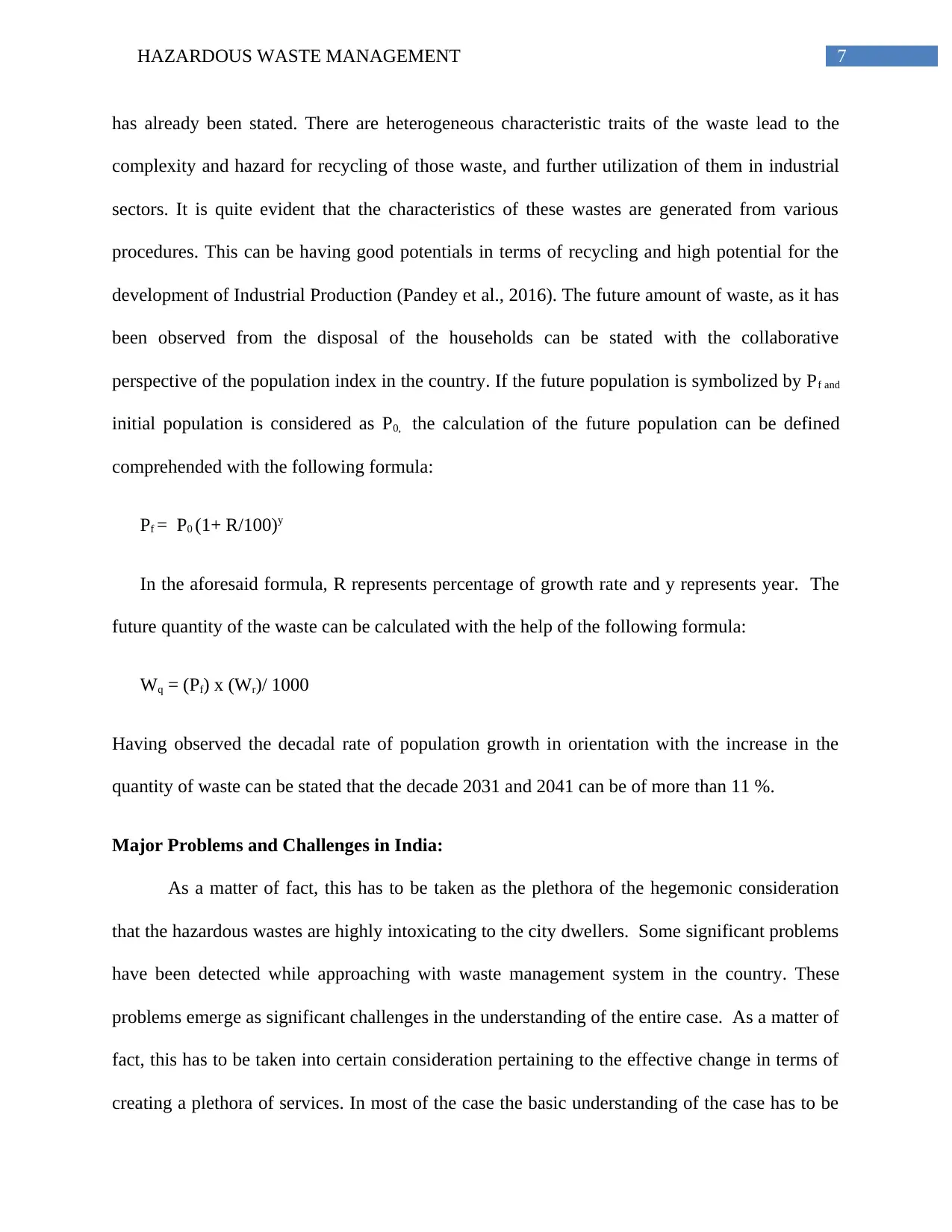
7HAZARDOUS WASTE MANAGEMENT
has already been stated. There are heterogeneous characteristic traits of the waste lead to the
complexity and hazard for recycling of those waste, and further utilization of them in industrial
sectors. It is quite evident that the characteristics of these wastes are generated from various
procedures. This can be having good potentials in terms of recycling and high potential for the
development of Industrial Production (Pandey et al., 2016). The future amount of waste, as it has
been observed from the disposal of the households can be stated with the collaborative
perspective of the population index in the country. If the future population is symbolized by Pf and
initial population is considered as P0, the calculation of the future population can be defined
comprehended with the following formula:
Pf = P0 (1+ R/100)y
In the aforesaid formula, R represents percentage of growth rate and y represents year. The
future quantity of the waste can be calculated with the help of the following formula:
Wq = (Pf) x (Wr)/ 1000
Having observed the decadal rate of population growth in orientation with the increase in the
quantity of waste can be stated that the decade 2031 and 2041 can be of more than 11 %.
Major Problems and Challenges in India:
As a matter of fact, this has to be taken as the plethora of the hegemonic consideration
that the hazardous wastes are highly intoxicating to the city dwellers. Some significant problems
have been detected while approaching with waste management system in the country. These
problems emerge as significant challenges in the understanding of the entire case. As a matter of
fact, this has to be taken into certain consideration pertaining to the effective change in terms of
creating a plethora of services. In most of the case the basic understanding of the case has to be
has already been stated. There are heterogeneous characteristic traits of the waste lead to the
complexity and hazard for recycling of those waste, and further utilization of them in industrial
sectors. It is quite evident that the characteristics of these wastes are generated from various
procedures. This can be having good potentials in terms of recycling and high potential for the
development of Industrial Production (Pandey et al., 2016). The future amount of waste, as it has
been observed from the disposal of the households can be stated with the collaborative
perspective of the population index in the country. If the future population is symbolized by Pf and
initial population is considered as P0, the calculation of the future population can be defined
comprehended with the following formula:
Pf = P0 (1+ R/100)y
In the aforesaid formula, R represents percentage of growth rate and y represents year. The
future quantity of the waste can be calculated with the help of the following formula:
Wq = (Pf) x (Wr)/ 1000
Having observed the decadal rate of population growth in orientation with the increase in the
quantity of waste can be stated that the decade 2031 and 2041 can be of more than 11 %.
Major Problems and Challenges in India:
As a matter of fact, this has to be taken as the plethora of the hegemonic consideration
that the hazardous wastes are highly intoxicating to the city dwellers. Some significant problems
have been detected while approaching with waste management system in the country. These
problems emerge as significant challenges in the understanding of the entire case. As a matter of
fact, this has to be taken into certain consideration pertaining to the effective change in terms of
creating a plethora of services. In most of the case the basic understanding of the case has to be
Paraphrase This Document
Need a fresh take? Get an instant paraphrase of this document with our AI Paraphraser
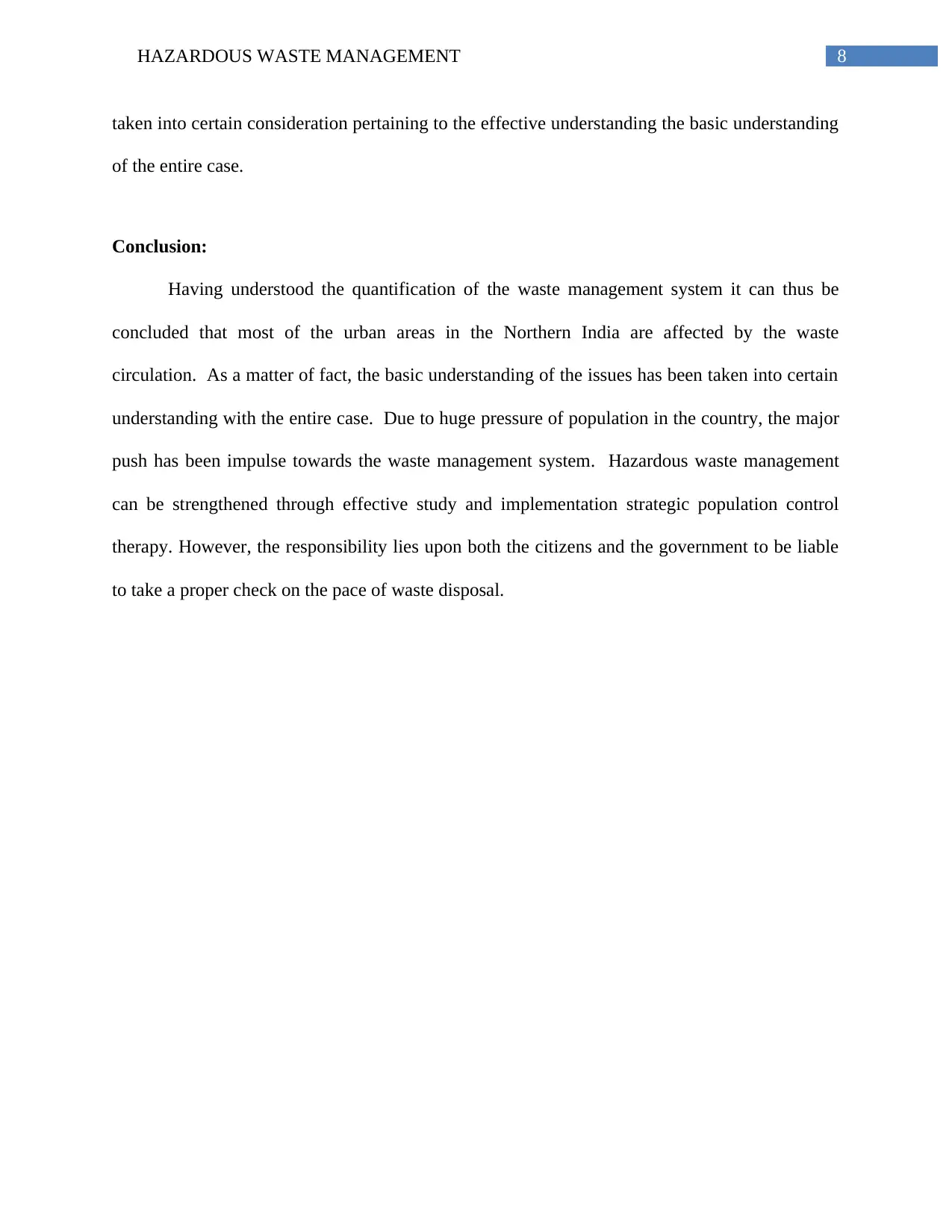
8HAZARDOUS WASTE MANAGEMENT
taken into certain consideration pertaining to the effective understanding the basic understanding
of the entire case.
Conclusion:
Having understood the quantification of the waste management system it can thus be
concluded that most of the urban areas in the Northern India are affected by the waste
circulation. As a matter of fact, the basic understanding of the issues has been taken into certain
understanding with the entire case. Due to huge pressure of population in the country, the major
push has been impulse towards the waste management system. Hazardous waste management
can be strengthened through effective study and implementation strategic population control
therapy. However, the responsibility lies upon both the citizens and the government to be liable
to take a proper check on the pace of waste disposal.
taken into certain consideration pertaining to the effective understanding the basic understanding
of the entire case.
Conclusion:
Having understood the quantification of the waste management system it can thus be
concluded that most of the urban areas in the Northern India are affected by the waste
circulation. As a matter of fact, the basic understanding of the issues has been taken into certain
understanding with the entire case. Due to huge pressure of population in the country, the major
push has been impulse towards the waste management system. Hazardous waste management
can be strengthened through effective study and implementation strategic population control
therapy. However, the responsibility lies upon both the citizens and the government to be liable
to take a proper check on the pace of waste disposal.
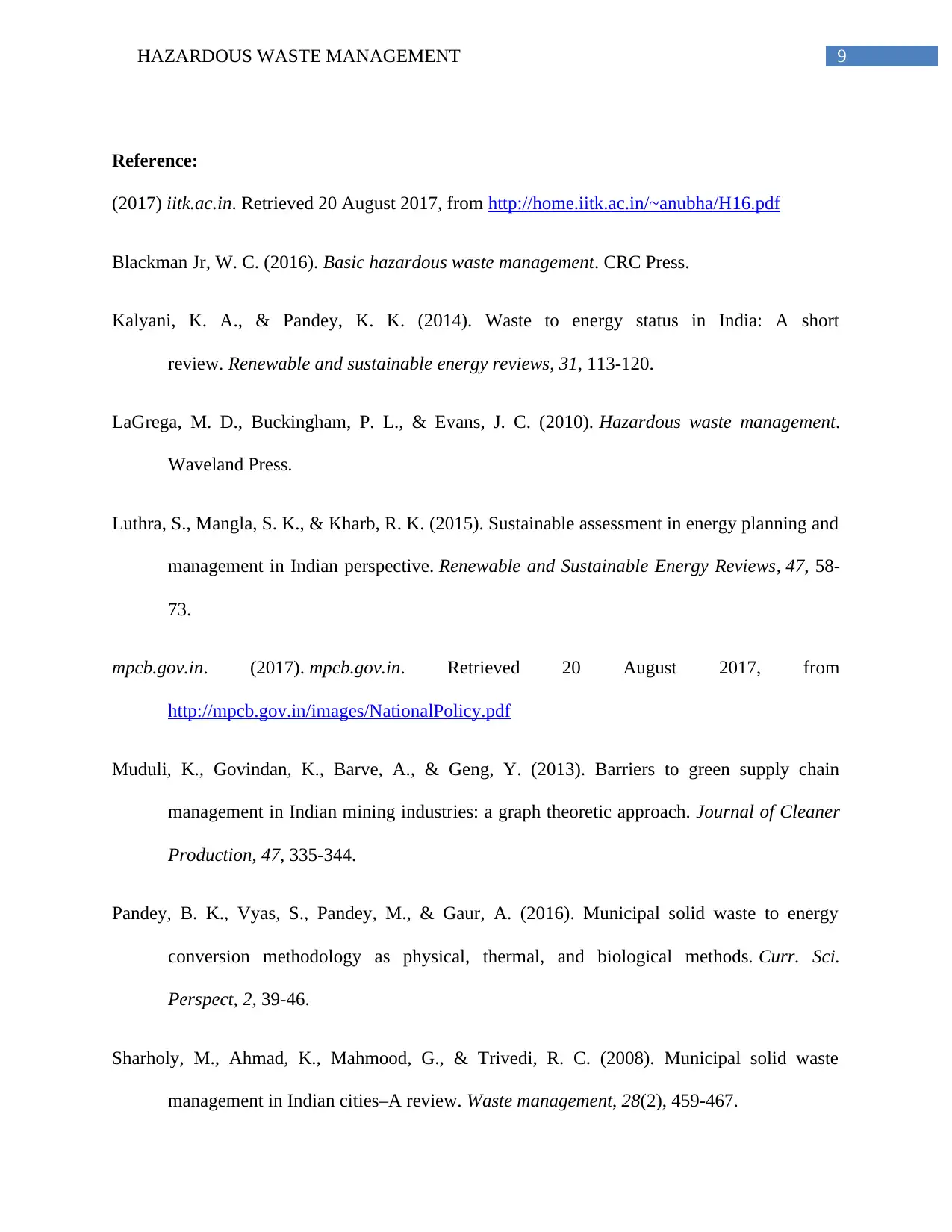
9HAZARDOUS WASTE MANAGEMENT
Reference:
(2017) iitk.ac.in. Retrieved 20 August 2017, from http://home.iitk.ac.in/~anubha/H16.pdf
Blackman Jr, W. C. (2016). Basic hazardous waste management. CRC Press.
Kalyani, K. A., & Pandey, K. K. (2014). Waste to energy status in India: A short
review. Renewable and sustainable energy reviews, 31, 113-120.
LaGrega, M. D., Buckingham, P. L., & Evans, J. C. (2010). Hazardous waste management.
Waveland Press.
Luthra, S., Mangla, S. K., & Kharb, R. K. (2015). Sustainable assessment in energy planning and
management in Indian perspective. Renewable and Sustainable Energy Reviews, 47, 58-
73.
mpcb.gov.in. (2017). mpcb.gov.in. Retrieved 20 August 2017, from
http://mpcb.gov.in/images/NationalPolicy.pdf
Muduli, K., Govindan, K., Barve, A., & Geng, Y. (2013). Barriers to green supply chain
management in Indian mining industries: a graph theoretic approach. Journal of Cleaner
Production, 47, 335-344.
Pandey, B. K., Vyas, S., Pandey, M., & Gaur, A. (2016). Municipal solid waste to energy
conversion methodology as physical, thermal, and biological methods. Curr. Sci.
Perspect, 2, 39-46.
Sharholy, M., Ahmad, K., Mahmood, G., & Trivedi, R. C. (2008). Municipal solid waste
management in Indian cities–A review. Waste management, 28(2), 459-467.
Reference:
(2017) iitk.ac.in. Retrieved 20 August 2017, from http://home.iitk.ac.in/~anubha/H16.pdf
Blackman Jr, W. C. (2016). Basic hazardous waste management. CRC Press.
Kalyani, K. A., & Pandey, K. K. (2014). Waste to energy status in India: A short
review. Renewable and sustainable energy reviews, 31, 113-120.
LaGrega, M. D., Buckingham, P. L., & Evans, J. C. (2010). Hazardous waste management.
Waveland Press.
Luthra, S., Mangla, S. K., & Kharb, R. K. (2015). Sustainable assessment in energy planning and
management in Indian perspective. Renewable and Sustainable Energy Reviews, 47, 58-
73.
mpcb.gov.in. (2017). mpcb.gov.in. Retrieved 20 August 2017, from
http://mpcb.gov.in/images/NationalPolicy.pdf
Muduli, K., Govindan, K., Barve, A., & Geng, Y. (2013). Barriers to green supply chain
management in Indian mining industries: a graph theoretic approach. Journal of Cleaner
Production, 47, 335-344.
Pandey, B. K., Vyas, S., Pandey, M., & Gaur, A. (2016). Municipal solid waste to energy
conversion methodology as physical, thermal, and biological methods. Curr. Sci.
Perspect, 2, 39-46.
Sharholy, M., Ahmad, K., Mahmood, G., & Trivedi, R. C. (2008). Municipal solid waste
management in Indian cities–A review. Waste management, 28(2), 459-467.
⊘ This is a preview!⊘
Do you want full access?
Subscribe today to unlock all pages.

Trusted by 1+ million students worldwide
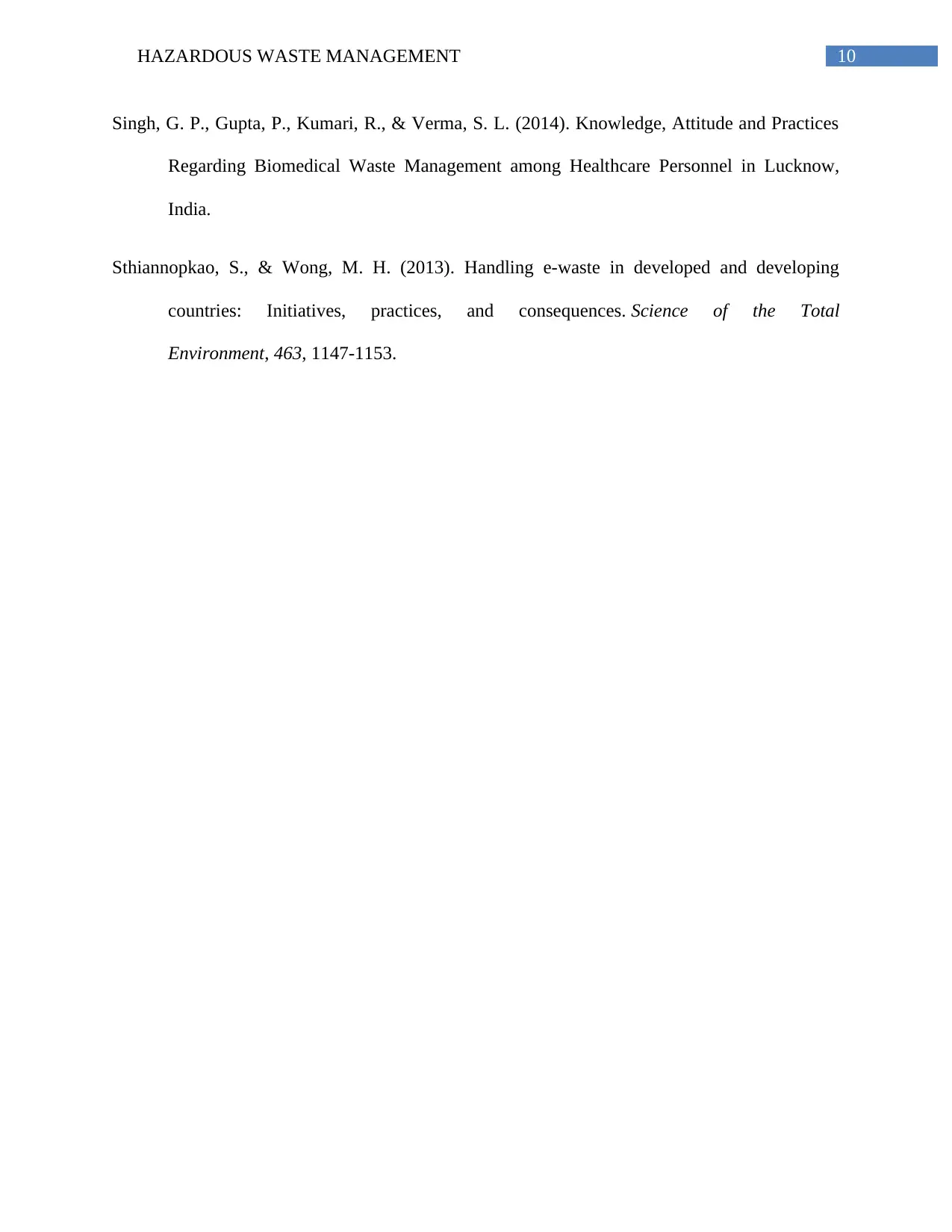
10HAZARDOUS WASTE MANAGEMENT
Singh, G. P., Gupta, P., Kumari, R., & Verma, S. L. (2014). Knowledge, Attitude and Practices
Regarding Biomedical Waste Management among Healthcare Personnel in Lucknow,
India.
Sthiannopkao, S., & Wong, M. H. (2013). Handling e-waste in developed and developing
countries: Initiatives, practices, and consequences. Science of the Total
Environment, 463, 1147-1153.
Singh, G. P., Gupta, P., Kumari, R., & Verma, S. L. (2014). Knowledge, Attitude and Practices
Regarding Biomedical Waste Management among Healthcare Personnel in Lucknow,
India.
Sthiannopkao, S., & Wong, M. H. (2013). Handling e-waste in developed and developing
countries: Initiatives, practices, and consequences. Science of the Total
Environment, 463, 1147-1153.
1 out of 10
Related Documents
Your All-in-One AI-Powered Toolkit for Academic Success.
+13062052269
info@desklib.com
Available 24*7 on WhatsApp / Email
![[object Object]](/_next/static/media/star-bottom.7253800d.svg)
Unlock your academic potential
Copyright © 2020–2025 A2Z Services. All Rights Reserved. Developed and managed by ZUCOL.





